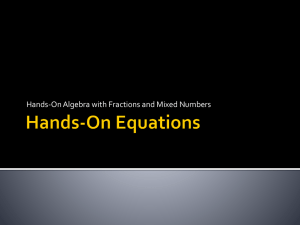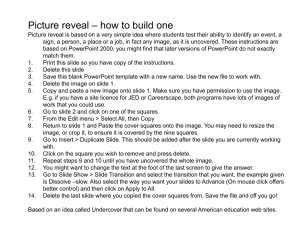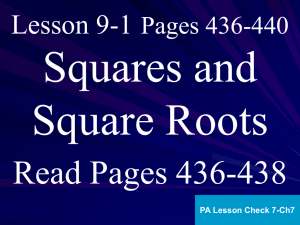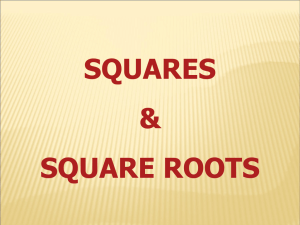11 Liftig
advertisement
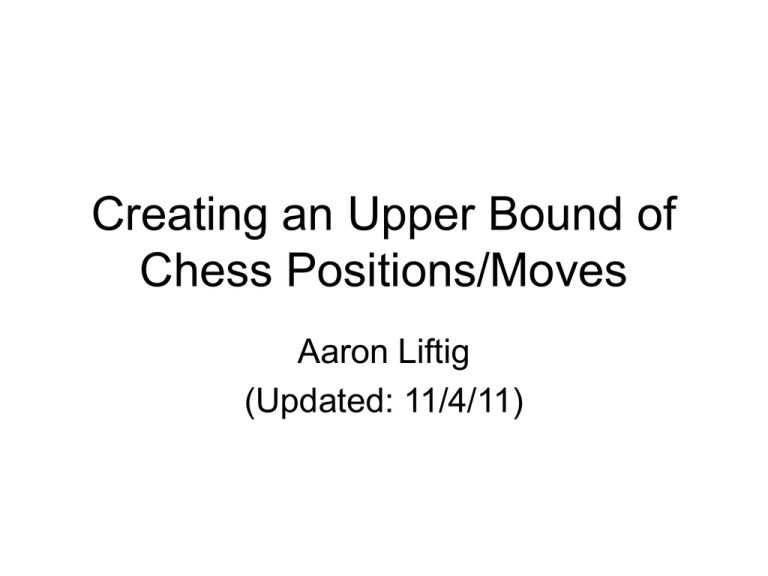
Creating an Upper Bound of Chess Positions/Moves Aaron Liftig (Updated: 11/4/11) Shannon Number • From Wikipedia: – Claude Shannon estimated the number of possible positions, “of the general order of, or roughly 10^43” • This includes some illegal positions (e.g., pawns on the first rank, both kings in check) and excludes legal positions following captures and promotions. • Many of such figures use estimates such as an approximate average length of a game, or an approximate value for possible moves of a random position. Victor Allis • Also from Wikipedia: – Using the figure and restrictions on the previous slide, Victor Allis calculated an upper bound of 5×10^52 for the number of positions and estimated the true number to be about 10^50. – Recent results disprove that estimate by proving an upper bound of only 2^155 which is less than 10^46.7. – Allis also estimated the game-tree complexity to be at least 10^123, "based on an average branching factor of 35 and an average game length of 80". – As a comparison, the number of atoms in the observable universe, to which it is often compared, is estimated to be between 4×10^79 and 10^81. A History of Refinement • To start, I attempted to create a maximum bound for the total number of positions and moves. • Positions: 97^64 – 16 pieces plus 16 pawns times their number of promotions, 5, plus 1 to account for empty squares to the 64, the number of squares. • Moves: 2(97^64)+1 – The figure from above times 2 plus 1 to account for three-fold repetition rules. A History of Refinement (cont.) • First, I attempted to look at the number of ways to choose 30 to 0 pieces out of 94 possibilities plus a constant 2 for kings each time. – I took this figure and multiplied the number of positional possibilities, keeping the lower bound at 2 for the fewest number of pieces that must be on the board. – For moves, I again multiply this by 2 and add 1 • Note: None of these earlier refinements are shown – only the final figure. A History of Refinement (cont.) • Then I decided to separate pawns and their promotions from the other pieces to get a more accurate figure. • I also attempted to subtract the number of illegal pawns positions of the 1st and 8th rank. – My way of going about this was wrong. I was thinking of subtracting the total number of pawn positions in the original figure and then adding back the positions allowed in the middle 48 squares. • Other refinements I attempted to include that were ultimately unsuccessful are drawn positions that when reached cannot repeat for the three-fold repetition rule. – I also wanted to include bishops remaining on their color throughout the entire game, but these are relatively negligible amounts to the greater total. Also, the amount of math required to reduce the greater total by this amount is immense. A History of Refinement (cont.) • The second to last estimate was still incorrect in many ways. It took all that I had gathered, including pawns and promotional possibilities, remaining pieces and kings (which was incorrectly calculated) times the number of positions of those piece configurations, minus the illegal pawn moves (again, incorrectly calculated). That times two when considering total moves, minus a few drawn positions (incorrectly implemented), plus 1. • I then spoke with Professor Beatty, and we discussed the number of lone kings configurations given the ‘one square between kings’ rule. This came in handy for my final figure. A History of Refinement (cont.) • • • • • • In my last estimate for an upper bound, I realized that my pawn and promotional idea was correct, and that the number of remaining pieces, excluding the king, should be multiplied by that amount. Then, I realized that 2 kings should be given to each of those configurations (a sum of the 255 variations of piece configurations minus the single lone kings possibility, making it 254 total terms in the sum), excluding the lone kings possibility because it convolutes the final figure. The number of positional choices for this amount became an intricate balance of the prior summations in order to have a more accurate final number. Also, I found that the number of positions choices for each piece configurations was a sum and not a finite product. I then added the lone kings configurations mentioned in the previous slide to this amount. I fixed the wrong illegal pawn positions refinement which became much more complicated than I had originally thought. This refinement, however, is a significant amount because it reduces all possibilities where at least 1 pawn is on an illegal square times all of the other possible piece placements that could occur (not including pawn promotions having taken place). On a side note, I removed the drawn lone kings, lone kings plus one minor piece, and lone king plus one minor piece each possibilities, because they only apply to a total move refinement and are relatively insignificant. Finally, the bound for the total number of moves would again be the number times 2 plus 1. Final Figure (Positions) • Here, x is meant to denote an operation where the corresponding combination is multiplied by each term where the sum of m and n are the same as the choosing value (excluding the plus 2 when considering only the m and n values). The asterisk is meant to denote an operator where terms with identical m and n values are multiplied by each other. Both the x and star’s roles are similar but not exactly the same. There may be a more exact way of doing this without the need for such operators. Other Potential but Somewhat Impractical Refinements • Knowing that the only pieces that can move on the first move of each side are the pawns and knights, a large refinement would be to reduce the number of positions from the initial pawns’ positions to only knight and, subsequently, rook moves around the board. The final figure still allows pawns to remain on their original squares with all other pieces to be scattered around the board. • Illegal positions of multiple checks – over two – are impossible because they can only occur with an exposed check, and only one piece’s line of sight toward the king can be exposed in a given move. • Pawn placements around the board are also limited (a pawn on the A-file cannot reach the H-file) and similar constraints. • As mentioned before, bishops must remain on their original square. • There are positions where if there is insufficient mating material, the position is drawn, so these would not be considered twice in the three-fold repetition rule. Updates • All further slides are updates • There are some mistakes in the previous final figure that I should address before anything else. – First, the “80-5m choose 16-m” term should just be “5m choose m”, given the way the “square-choosing term” is arranged. – Also, the two operators’ duty is fulfilled by simply bringing the “square-choosing terms” inside the summations. – Finally, in the final figure, I left out a term which places the pieces. This term significantly increases the total, essentially doubling it. In that figure, it would take the form, (m+n+2)!. Separating Pawns from Promotions • In the process of continuing to refine the upper bound, I have separated the pawns from their promotions, as it more accurately represents the possible piece arrangements and allows for the pawns to be placed on 48 possible squares as opposed to the 64 of the entire board, lessening the total and eliminating the need for the reduction term of the previous final figure. – Before separating the pawns and promotions, I had gotten as far as using a “5^x” term summing from 0 to 16 to represent the pawn and promotion possibilities. – I then separated that into “t, from 0 to 16” for the pawns and a “4^x, from 0 to 16-t” for the promotions. New Pawn and Promotion Terms • A slight improvement for the pawns is that the process of choosing 0 to 16 items of two 8 element sets with interchangeable elements (white and black pawns) can more accurately be represented, “-|t-8|+9”. • The pawn promotion “4^x” term can more accurately be represented by “x+3 choose 3 from 0 to 16-t” which is derived based on the replications of promotion choices; for instance, a pawn promoted to a knight and another promoted to a queen is the same reversed. In speaking with Professor Sullivan, A way of understanding this term is that it may also be represented geometrically by a hypertetrahedron as opposed to the exponential term’s representation as a greatly encompassing hypercube. New Pieces Term • The prior “14 choose n” term can more accurately be represented by “(6 choose z)(8-z choose y-2z), y from 0 to 14, z from 0 to 6.” – With the piece choices, White: Q RR NN BB; Black: q rr nn bb, where the rooks, knights (represented by N,n), and bishops are interchangeable, there is much redundancy in the “14 choose n” term. So in the new term, “6” represents the number of sets with an equal number of interchangeable elements; “8” represents the 6 sets plus the two queens; “2” represents the number of interchangeable elements in each of the 6 sets; “y” represents the number of pieces; and “z” is a variable that essentially sees how many sets can be applied for a given why “y” value. – • • – I am not 100% on this term, but it seems to represent the possible piece choices. There is no significance as to why t, x, y, and z are used but that they are easily accessible on a TI-89. Note: In calculating this, the calculator finds all “undefined” combination terms, nCr, where “r” is negative (i.e. when “y” is too small relative to “z”) to be zero, avoiding any issue. New “Square-Choosing” and Placement Terms • The pawns can access up to 48 squares on a chessboard, as they cannot reach their 1st rank and promote after reaching their 8th. Therefore, the square-choosing term for pawns is “48 choose t”. – I am currently attempting to refine this term, because pawns on the a, b, g, and h files cannot reach all 48 squares as mentioned above. This, however, requires the term of choosing the pawns (the absolute value term) to be adjusted to exclude these particular pawns. Also, a mathematical representation of the dynamic of how pawns interact with each other, given the squares they are legally able to reach, is not easily apparent to me at this time. • Including the bishops for the sake of simplicity, the pieces, promotions, and two kings are able to access all 64 squares minus the squares on which the pawns are already. Therefore, this term looks like, “64-t choose x+y+2”. – The “z” term needn’t be included in any of these, as it simply picks the number of applicable sets for the pieces, “y”, term. • The placement term, (x+y+t+2)!, takes the total number of pawns, promotions, pieces, and a constant two kings, and distributes them onto the squares given by the square-choosing term. The Result • Here, the 2 multiplied at the beginning of the expression is used because it’s the simplest way to account for the kings. One could also use the way mentioned in the previous expression in order to have a slightly more accurate total. • The total of this expression is approximately 9.83x10^63 In conclusion, • A possible and ongoing refinement is attempting to reduce the number of illegal check positions for the pieces, i.e. positions with impossible double checks and checks with three or more pieces (and both kings simultaneously in check). From this, I found that probabilistically a king in the center of the board early in the game, while being vulnerable to checks and mate in general, is, in a sense, “closer” to illegal positions as well. That is why we tend not to put the king there so early in a game. So on a side and lighter note, I have come to the conclusion that chess is a game of unknowingly avoiding illegal positions… and walking a tightrope to near them.

